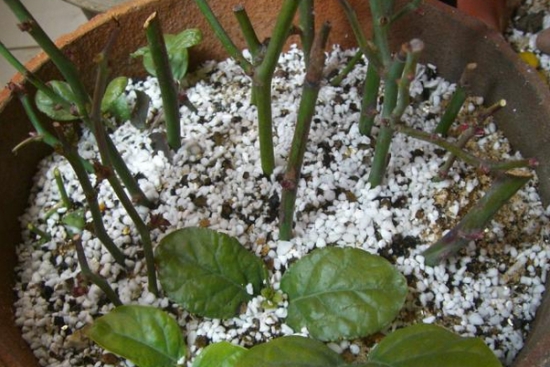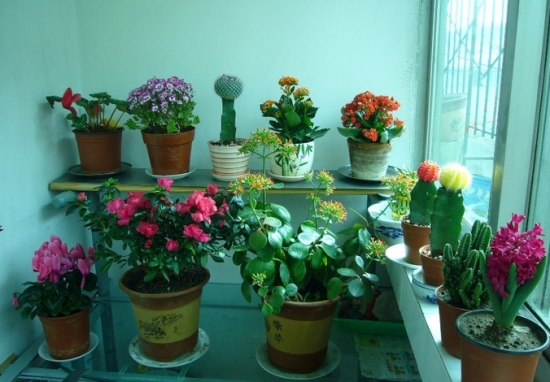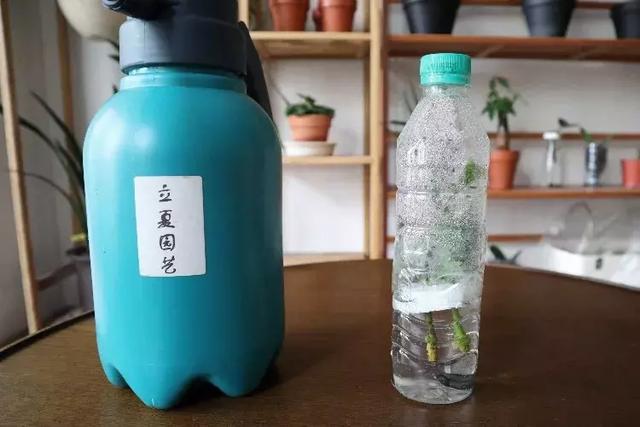How to cuttage and propagate flowers
There are many kinds of flowers suitable for cutting, such as rose, hibiscus, glass Cui, silver star begonia, etc.; leaf cutting mainly includes chrysanthemum, hairy leaf begonia and so on.
1. The soil used for cutting requires good drainage and ventilation. The ambient temperature of cutting flowers is better at 20: 25 ℃.
2. The relative humidity should be kept at no less than 60%.
3. Cutting the cuttings should cut the selected branches flat or obliquely from the bottom affixed to a leaf. Because this part of the cambium is active, the accumulation of nutrients is more, and it is easy to root. Keep at least three buds up. Begonia with hairy leaves should be cut at the length of petiole 4cm to 5cm. Chrysanthemums should be cut from part of the skin on the stem at the base of the petiole root.
4. When cutting cuttings, it should be carried out immediately after cutting the cuttings, so as not to dry up and affect rooting. Cut rose, hibiscus, Lingxiao and other cuttings cut in autumn, since there is no temperature condition for immediate cutting, the cut cuttings can be tied into bundles and buried in flowerpots with moist coarse sand and placed at room temperature of 0: 5 ℃. Be careful not to make the sand too dry so that it can be inserted again next year.
Glass Cui, four Seasons Begonia, oleander and so on, after cutting the cuttings, you can soak them in clear water first, and then plant them in a pot after soaking out the roots. Rose and Milan can dip the lower mouth of the stab in vitamin B12 injection water and insert it into the coarse sand after 1-2 seconds, which has the effect of promoting rooting. After cutting, cover the basin soil with a layer of plastic film to maintain temperature and humidity. At the same time, we should pay attention to the flowerpot in a cool, ventilated place, do not be directly exposed to El light. Such as early spring, late autumn or winter, when the temperature is not enough, the flowerpot should be moved to the stove or near the heater to increase the temperature, and observe the adjustment of temperature and humidity at any time.
How to cuttage and propagate flowers
Cutting propagation is to make use of the regeneration ability of plant roots, stems, leaves and buds to make it take root and sprout to form new plants under appropriate conditions. The advantages are: maintain the characteristics of each plant; bloom earlier than seed reproduction; breeding method is simple, convenient to obtain materials, high survival rate; when the conditions are available, all seasons can be carried out; species that can not bear fruit can be propagated by this method. The disadvantage is that the root system of the cutting plant is shallow and the growth period is short. Stem cuttings include hardwood cuttings and soft cuttings.
First, hardwood cutting: pomegranate, hibiscus, hibiscus, crape myrtle, spring, poinsettia and other deciduous flowers and trees often use this method. Before the sap flows in early spring. Select 1-year-old, 2-year-old strong and full branches, select the middle section, cut the branches into 10mur15cm long branches as cuttings, need to carry 2murs and 3 buds, and the top buds should be full and intact. The upper end is 0.5 cm above the bud, cut into a flat mouth, and the lower end is 0.5-1 cm under the bud, cut into an oblique mouth, and the bud is on the side of the tip of the oblique mouth, which is inserted into the cutting medium with a depth of 1 × 2 cuttings. Hardwood cuttings most tree species are buried in the ground before winter and replanted in spring. Some tropical and subtropical flowers and trees can also be cut in advance in the greenhouse.

Cutting Propagation of Rose
Second, soft wood cutting: greenhouse flowers such as inverted golden bell, geranium, begonia, open grass flowers such as a string of red, dahlia, beautiful cherry, evergreen broad-leaved flowers such as jasmine, rhododendron, Michelia, camellia, sweet-scented osmanthus, etc. From late May to September. Select the semi-lignified branches with leaves in the same year as cuttings, such as the semi-lignified branches at the lower end of the proximal tip after anthesis. The cuttings are about 6 Mel 10 cm long and should have 2 mi 3 buds. The cutting method is like a hard branch, and the lower leaves are cut off, while the upper leaves can be cut off as appropriate to reduce evaporation. The survival rate of cutting and inserting is the highest. When cutting poinsettia, geranium, oleander and other cuttings, a large amount of juice is often discharged from the incision, which must be inserted after the incision is dry, otherwise the incision is easy to rot and difficult to survive.
Third, leaf insertion: Begonia, chrysanthemum, stone lotus, tiger tail orchid and other species that can grow adventitious roots and buds at the vein or petiole, and can be propagated into new plants. When cutting a leaf with a petiole, keep the petiole about 3 cm, cut off part of the thin and tender leaf margin, and insert the petiole into the matrix; if there is no petiole, you can cut it with a knife at the intersection of the leaf vein and lay the leaf flat on the matrix to make it in close contact with the matrix, or fix the leaf vein in the matrix with a bamboo stick, which can root at the vein and grow into a new plant. Tiger tail orchid for fleshy sword-shaped leaves, can be transversely cut into about 5 cm leaf segments for cuttings, inserted directly in the sand, do not be upside down, new roots can occur at the base to form new plants.
Fourth, leaf bud insertion: rubber tree, eight immortal flowers, jasmine, mulberry and so on in the leaf insertion, although its petiole and leaf axil can take root, but can not sprout, therefore, can not grow into a new plant. Therefore, it is necessary to choose the leaf cuttage with an axillary bud at the base in order to develop into a new plant.
Fifth, root insertion: stick stem begonia, peony, Lingxiao, kiwifruit, hypericum, wax plum, persistent root Fu Lukao, lotus peony and so on. Flowers that can grow adventitious buds on their roots can be propagated by root cuttings. When the flowers and trees change pots, cut 5mur10cm root segments, insert them directly or obliquely into the soil, not upside down, and the upper end is flat with the soil surface, and then cultivate the soil properly after the new buds grow.
No matter what kind of cutting method is adopted, we must pour enough water after cutting, and then cover the cutting pot with glass or plastic film, in order to maintain a certain temperature and humidity, put it in the semi-shade, strengthen management, and then transplant and culture after rooting. In order to make the cuttage survival rate high, in addition to selecting good cuttings, the substrate is also very important, the substrate should not only have good drainage, but also have a certain degree of water retention. Vermiculite, perlite, slag and rice bran ash are better cutting substrates. The substrate should be kept above 20 ℃, that is, the atmospheric temperature should be above 25 ℃, so that the cuttings can be easily healed and rooted.
How do flowers propagate by cuttings? Flower cutting propagation is a propagation method which makes use of the regeneration ability of branches, leaves, buds and roots to sprout new branches and leaves and develop into an independent new plant. This method belongs to asexual reproduction. Spring and autumn is the best time for flower cutting propagation, when cutting propagation is carried out, the survival rate is very high. Although the temperature and humidity are different in different regions, cuttings can be carried out as long as the temperature is between 13 and 25 ℃. Tropical xerophytes, such as cacti, can be cut at higher temperatures. Flower cutting is roughly divided into two types: one is soft wood cutting, that is, semi-lignified branches in the growth period are used as cutting materials; the other is hardwood cutting, that is, the techniques, buds and roots from falling leaves in autumn to sprouting in spring are used as cutting materials. As soft wood cuttings can be carried out all the year round, people often use them. In soft wood cutting, the cuttings of chrysanthemum, a bunch of red, glass begonia, dahlia and other herbaceous flowers should be selected for the hardened shoots of the current year. For the cuttings of woody flowers such as rose, cloves, strangers, rhododendron, bell, mulberry, pomegranate and other woody flowers, the woody or semi-lignified branches of the current year should be selected, and it is best to adopt the semi-woody cuttings at the lower end of the proximal tip after flowering. The specific method of cutting propagation is to first select the techniques for growing and enriching without diseases and insect pests, each section is 5-10 cm long, and there are about 4-6 leaf nodes. Then the leaf node at the lower end of the branch is 2-3 cm. Cut a Mal-shaped incision to increase the nutrient absorption area, and cut off the leaves on the cuttings, leaving only one or two leaves at the top. The sap will flow from the cuttings of some plants, such as bamboo cuttings, poinsettias, cacti and other succulent plants, which need to wait for the wound to dry and heal before cutting, otherwise the cut will rot soon after cutting. Other flowers and trees should generally be cut and inserted to keep them fresh. If there are conditions, the cuttings can be dipped in vitamin B solution, taken out and inserted into the soil for two minutes to promote wound healing and rooting. In general, the cuttings are inserted into clean river sand. But practice has proved that using sapphire powder (also known as Shangshui stone, which is a natural mixture of aluminum and magnesium, with a thin flake like mica-like mineral) as a slotting machine has the best effect, because it has a variety of trace elements and good ventilation, and can maintain a certain amount of water. the cuttings can take root quickly and the survival rate is higher. The depth of cutting is 2/3 of cuttings in spring and autumn and 1/2 in summer. If you can illuminate the inserting bed with light at night, it is more conducive to cuttings rooting ahead of time and improve the survival rate.
- Prev

How to apply Fertilizer to Flowers in Family farming
As the root growth of potted flowers and trees is limited and the intake of nutrients is less, it is necessary to have sufficient fertilizer to ensure its normal growth and development. But it is not that the more fertilizer, the better, requiring timely and appropriate amount. It is understood that there are many examples of flower deaths caused by the use of fertilizer or improper watering by family flower lovers.
- Next

Gardenia cut like this, it is very simple and easy to take root!
The gardenia cut by the Beginning of Summer with a mineral water bottle finally took root. It seems to have been used for more than ten days, but I can't remember the details very clearly. Cutting gardenia in this way can generally take root in 1-2 weeks. In about a week or so, I saw a lot of bags bulging on the branches, with very few showing white spots.
Related
- Fuxing push coffee new agricultural production and marketing class: lack of small-scale processing plants
- Jujube rice field leisure farm deep ploughing Yilan for five years to create a space for organic food and play
- Nongyu Farm-A trial of organic papaya for brave women with advanced technology
- Four points for attention in the prevention and control of diseases and insect pests of edible fungi
- How to add nutrient solution to Edible Fungi
- Is there any good way to control edible fungus mites?
- Open Inoculation Technology of Edible Fungi
- Is there any clever way to use fertilizer for edible fungus in winter?
- What agents are used to kill the pathogens of edible fungi in the mushroom shed?
- Rapid drying of Edible Fungi

